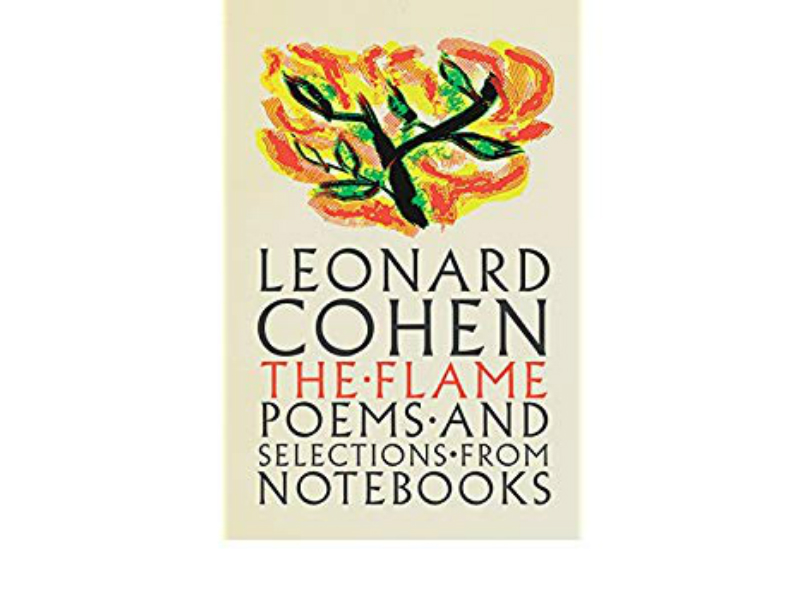The recent publication of Leonard Cohen’s The Flame: Poems and Selections from Notebooks is a project that was begun when Cohen was alive, and was finished through the collaborative work of its two editors after his death. They confirm that up to “the last months of his life,” Cohen was involved in making selections for the volume. This work then ran in tandem with his final musical project, You Want it Darker, which was released a few weeks before he died.
The material in The Flame is an idiosyncratic gathering, described by its editors as “sixty-three poems … from a trove of unpublished work that spans decades,” “lyrics from his last four albums” and entries from notebooks that Cohen kept “up until the last days of his life.”
Most of the poems and notebook selections are undated, so one can only sporadically tell how they fit with other more familiar work, or with biographical or world events. The song lyrics span Cohen’s recorded output between 2006 and 2016. The Flame is a kind of overview, or anthology, of Cohen’s writerly legacy from the late decades of his career.
READ: LEONARD COHEN EXHIBIT TO GO ON INTERNATIONAL TOUR
Illustrating the text are many sketches and self-portraits of the type Cohen first included in his 2006 collection, Book of Longing, and which sometimes showed up on Internet fan sites like the Leonard Cohen Files. In a few cases, the editors have included a reproduction of Cohen’s own handwritten work, which lends The Flame the look of a private scrapbook or archival album.
A few of the sharper pieces in The Flame are instances of self-criticism. Flying Over Iceland reviews a reception in Reykjavik where Cohen,
a second-rater
by any estimation,
was honoured by the noblest
and handsomest people of the West
In a similar vein is a notebook entry from 2008, titled Dream Brighton. Cohen records a dream, in which he, having finished his own concert, becomes aware that Tom Waits is performing in a neighbouring theatre:
My show went well – I can’t
see him – I’m in my dressing
room – but I can hear him –
his music begin – it is so
beautiful and original and
sophisticated – so much better
than mine – some mélange
of harshness and sweetness
This is Cohen at his best, in his lightly ironic mode of self-mockery reminiscent of the much favoured lyric from Tower of Song that laments his fated birth with a “golden voice.”
Cohen’s last decade brought him great honour and his most substantial popularity, while even his once-neglected mid-career work – including the album that contained Hallelujah – received a worldwide hearing. Still, no one reading The Flame who values Cohen’s best work, his audacious early poetry and his masterly early lyrics, would see these collected works in the same light. Even the lyrics on show from the albums Blue Alert, Old Ideas, Popular Problems and You Want it Darker pale in comparison with the words from earlier albums.
The editors do not play their hand on this subject. Cohen, for them, is beyond criticism, even if their subject, writing in his late years, was willing to consider himself with wry objectivity.
Two pieces unlike much of the rest in The Flame stand out: one is angry, an attack on artistic pomposity; the other is evidence of Cohen’s capability for modesty and self-diminishment in the face of heightening appreciation of his work.
This form of adulation and intense attention contributed to a shifting persona – a new stage in Cohen’s relationship with his audience – which, upon his death, moved in the direction of apotheosis, the confirmation of Cohen as a kind of popular saint. This late stage of Cohen’s public life bears little resemblance to his youthful stance, which relied on a mixture of con and offbeat intelligence. Nor is it reminiscent of the bleakness of his middle age, which produced work of great bitterness and irony regarding a failed marriage and the prospect of his own artistic future.
There are mere glimmers of these earlier versions of the author in The Flame.
A strange and compelling example of such writing, dated early 2015, is titled, Kanye West is Not Picasso:
Kanye West is not Picasso
I am Picasso
Kanye West is not Edison
I am Edison
I am Tesla
Jay-Z is not the Dylan of anything
I am the Dylan of anything
I am the Kanye West of Kanye West
Here, one finds the old doubt and irony regarding the relationship between fame and creativity, couched in bitter humour.
One of the best and most revealing pieces in The Flame comes last. It is the acceptance speech Cohen offered in 2011, upon being awarded Spain’s Prince Asturias Prize (now known as the Princess of Asturias Awards) for achievements in the sciences, the humanities and public affairs. In the speech, one hears echoes of the voice Cohen used to introduce poems in university halls in the mid-1960s, before anyone knew that he would soon transform himself into a performer of folk songs.
To the Spaniards, Cohen told a story of his first guitar, and of a remarkable scene of instruction in the park behind his “mother’s house in Montreal.” There, when he was nearly 30, he stumbled upon a man playing Spanish guitar. The two embarked on a short-lived teacher-student relationship, from which Cohen learned the Flamenco chord progression, “six chords,” he said, became “the basis” of all his songs.
It’s a great and honest offering, and for the Spaniards who heard it, a gracious revelation. In it, one catches the rare qualities of Cohen at his best.
